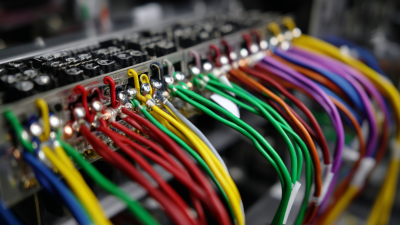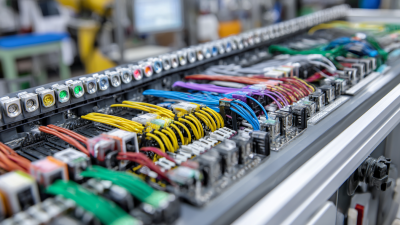Innovative Applications of Molded Cable Assemblies Across Various Industries
In today's rapidly evolving technological landscape, molded cable assemblies have emerged as critical components across a multitude of industries, from telecommunications to automotive manufacturing. As per a report by Allied Market Research, the global market for cable assemblies is expected to reach $254.67 billion by 2027, reflecting a compound annual growth rate (CAGR) of 8.5% from 2020. This growth underscores the increasing reliance on molded cable assemblies due to their durability, efficiency, and the ability to withstand harsh environmental conditions.
 By integrating advanced designs and innovative manufacturing techniques, industries are realizing significant improvements in performance and reliability, thus optimizing their operational efficiency. This guide explores the diverse applications of molded cable assemblies and highlights their transformative impact on modern industrial practices.
By integrating advanced designs and innovative manufacturing techniques, industries are realizing significant improvements in performance and reliability, thus optimizing their operational efficiency. This guide explores the diverse applications of molded cable assemblies and highlights their transformative impact on modern industrial practices.
The Basics of Molded Cable Assemblies and Their Core Benefits
 Molded cable assemblies have become essential components across various industries, serving as reliable connections that enhance both performance and durability. These assemblies typically consist of cable strands encased in a molded exterior, which provides significant protection against environmental factors such as moisture, dirt, and extreme temperatures. According to a market research report by Mordor Intelligence, the global molded cable assembly market is expected to grow at a compound annual growth rate (CAGR) of around 5.8% between 2021 and 2026, highlighting their increasing significance in industrial applications.
Molded cable assemblies have become essential components across various industries, serving as reliable connections that enhance both performance and durability. These assemblies typically consist of cable strands encased in a molded exterior, which provides significant protection against environmental factors such as moisture, dirt, and extreme temperatures. According to a market research report by Mordor Intelligence, the global molded cable assembly market is expected to grow at a compound annual growth rate (CAGR) of around 5.8% between 2021 and 2026, highlighting their increasing significance in industrial applications.
One of the core benefits of molded cable assemblies lies in their ability to reduce downtime and maintenance costs. A report from Allied Market Research indicates that the total cost of machinery downtime can reach up to $1 million per hour in some industries. The enclosed nature of molded cable assemblies minimizes wear and tear, ensuring better longevity and reliability. This is particularly crucial in sectors like automotive and telecommunications, where consistent performance and quick responses are vital. By incorporating these assemblies, companies are not only ensuring robust performance but also making a strategic investment in efficiency and operational excellence.
Key Industries Leveraging Molded Cable Assemblies for Enhanced Performance
Molded cable assemblies have emerged as essential components across multiple industries, significantly enhancing performance and reliability. In the telecommunications sector, for instance, the global market for molded cable assemblies is projected to reach $20 billion by 2026, with a compound annual growth rate (CAGR) of 7.5% from 2021 to 2026. This growth is largely driven by the increased demand for high-speed data transfer and the proliferation of smartphones and interconnected devices. Molded cable assemblies' ability to withstand environmental stressors while delivering efficient signal transmission makes them ideal for use in telecommunication infrastructure.
In the automotive industry, molded cable assemblies are transforming vehicle connectivity and safety features. With the rise of electric vehicles (EVs) and advanced driver-assistance systems (ADAS), the demand for durable and efficient wiring solutions is more critical than ever. According to a recent report by Allied Market Research, the automotive molded cable assembly market is expected to grow to $12.8 billion by 2027, reflecting a CAGR of 8.1%. These assemblies not only enhance the performance of electrical components but also contribute to weight reduction and improved energy efficiency, aligning with the industry's shift towards sustainability.
Innovative Applications of Molded Cable Assemblies Across Various Industries
How to Choose the Right Molded Cable Assembly for Your Application
When choosing the right molded cable assembly for your application, it's essential to consider a variety of factors to ensure optimal performance and longevity. First, assess the specific environmental conditions the assembly will face, such as temperature fluctuations, exposure to moisture, and potential physical stress. This consideration will help you select materials and designs that can withstand these conditions effectively.
**Tips:** Always check the cable assembly’s ratings for water and dust ingress protection, commonly referred to as IP ratings. Choosing assemblies designed for harsh environments can prevent premature failure.
Another critical aspect is the electrical requirements of your application. Verify the voltage and current specifications to ensure compatibility. Selecting a molded cable assembly that can handle the necessary power levels without risk of overheating or signal loss is vital for maintaining efficiency.
**Tips:** Consult with manufacturers for technical data sheets or samples to confirm that the assembly meets your specifications, ensuring that you find the best fit for your project’s needs.
Innovative Applications of Molded Cable Assemblies Across Various Industries
| Industry | Application | Cable Type | Key Features |
|---|---|---|---|
| Automotive | Engine Control Units | Shielded Twisted Pair | High Flexibility, Temperature Resistance |
| Aerospace | Cabin Connectivity | Multiconductor Cable | Lightweight, Low Outgassing |
| Healthcare | Diagnostic Equipment | Medical Grade Cable | EMI Shielding, Biocompatibility |
| Industrial Automation | Robotic Systems | Hollow Cable Assembly | High Flex Life, Oil Resistant |
| Telecommunications | Data Transmission | Fiber Optic Cable | High Bandwidth, Low Attenuation |
Innovative Design Techniques in Molded Cable Assemblies for Modern Demands
Molded cable assemblies have become pivotal in meeting the evolving demands of modern industries, especially with the rise of automation and smart technology. Innovative design techniques, such as over-molding and potting, enhance both the durability and functionality of these assemblies. According to a recent report by MarketsandMarkets, the global market for molded cable assemblies is projected to reach $45.4 billion by 2025, with a compound annual growth rate (CAGR) of over 7%. This growth can be attributed to the increasing need for reliable connectivity solutions in sectors like automotive, telecommunications, and medical devices.

Incorporating advanced materials such as thermoplastics and elastomers not only improves the physical properties of molded cable assemblies but also enables manufacturers to meet stringent safety and performance standards. For instance, the automotive sector is emphasizing lightweight components to improve fuel efficiency, spurring innovations in molded cable design. A report by ResearchAndMarkets states that the automotive segment alone is expected to account for approximately 35% of the molded cable assembly market share by 2025. This trend highlights the industry's shift towards embracing technology that not only enhances performance but also adheres to environmental regulations.
Future Trends: The Evolution of Molded Cable Assemblies in Industry Applications
The evolution of molded cable assemblies is reshaping various industries by enhancing connectivity, reliability, and efficiency. As technology progresses, the designs of these assemblies are becoming increasingly sophisticated, with advancements such as integrated strain relief and improved environmental resistance. Industries ranging from automotive to telecommunications are adopting these innovations to meet the demands of modern applications, driving a need for custom solutions that cater to specific requirements.
Tip: When selecting molded cable assemblies, consider factors such as flexibility, durability, and compatibility with existing systems. Opting for high-quality materials can significantly impact the overall performance of the assembly, ensuring longevity and reliability in various environmental conditions.
Looking towards the future, we can expect molded cable assemblies to integrate more smart technologies, including built-in sensors and data transmission capabilities. This integration will not only simplify installations but also allow for real-time monitoring and diagnostics, enabling preventative maintenance across sectors. As industries continue to evolve, staying informed about the latest trends in cable assembly technology will prove essential for optimizing operations.
Tip: Regularly assess your cable assembly suppliers for emerging technologies and solutions that can enhance your products' performance. Collaboration with manufacturers who prioritize innovation will keep your systems competitive in a rapidly evolving marketplace.



